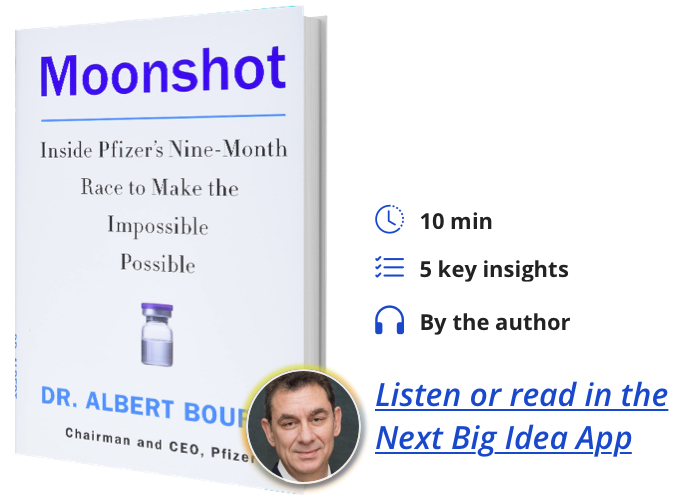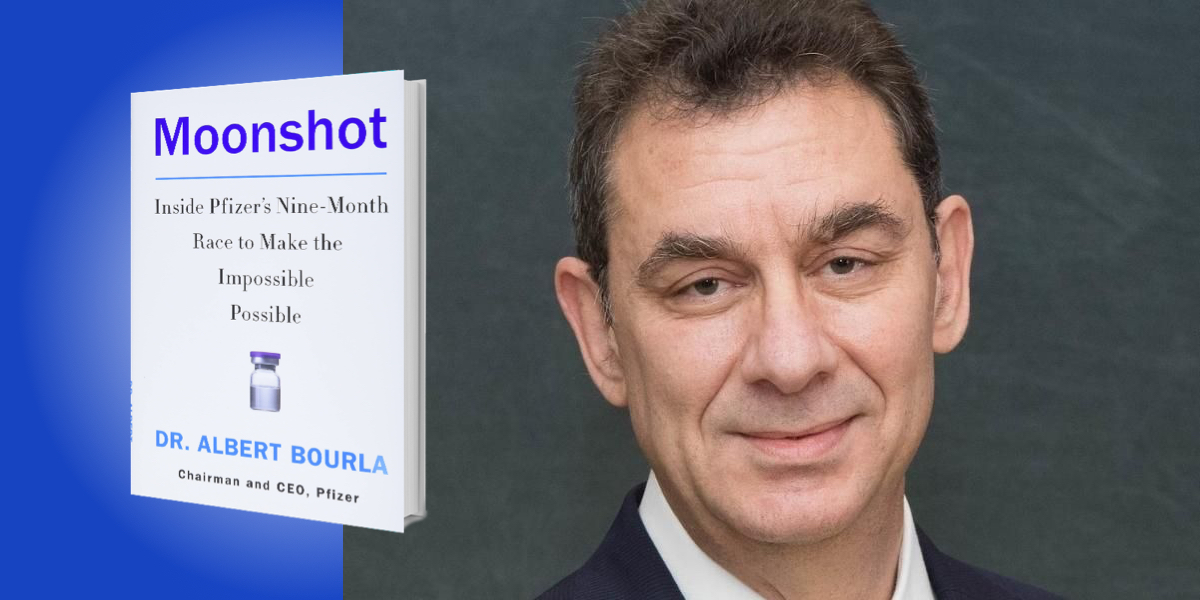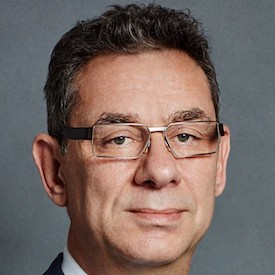As the CEO of Pfizer, Dr. Albert Bourla oversaw the development of a safe and effective COVID-19 vaccine, compressing an R&D timeline that usually takes years down to just eight months. In recognition of this miraculous work, he was named CEO of the year by CNN Business in 2021.
Below, Albert shares 5 key insights from his new book, Moonshot: Inside Pfizer’s Nine-Month Race to Make the Impossible Possible. Listen to the audio version—read by Albert himself—in the Next Big Idea App.

1. Luck doesn’t come to the unprepared.
When I became CEO of Pfizer in 2019, I had no idea what the future held. Just one year later, we found ourselves taking on the greatest challenge in modern history: developing a COVID-19 vaccine in record time. Our success did not happen by chance; it happened because of the steps we had taken before the pandemic to transform Pfizer into a more innovative, science-driven company.
The most important part of our transformation was establishing a culture that allows innovation to thrive. This culture enabled us to think differently about the way we work, to make bold decisions, and to focus on delivering breakthroughs. It also enabled us to cut through bureaucracy and get things done at light speed. That is the story of our moonshot.
2. Don’t be afraid to make bold moves.
In life, our problem is not that we aim too high and miss; it’s that we aim too low and hit. Setting extremely ambitious goals does not restrain human ingenuity—it liberates it.
Time was the most important factor for the success of this project. When you ask people to do in eight years something that normally takes 10, they will find it challenging, but they will think of solutions. If you ask them to make 300 million doses instead of 200 million doses—that was our current annual capacity at the time—they will find it hard, but they’ll investigate solutions that improve the current way of doing things.
“In life, our problem is not that we aim too high and miss; it’s that we aim too low and hit.”
In the case of the COVID-19 vaccine, I didn’t ask people to do it in eight years; I asked them to do it in eight months. I didn’t ask them to make 300 million doses; I asked them to make three billion doses. And I insisted that these targets were non-negotiable.
Keep in mind, this wasn’t an ask about a process they had done before. Previously, we had only produced mRNA in laboratories, at small scale, for research needs. Our manufacturing team would have to invent, design, and order industrial formulation equipment that didn’t exist. And they would have to do these steps in parallel to save time.
It was clear from the beginning that incremental improvements would not make the cut. They needed to completely rethink their processes, because every month we delayed meant thousands more sick and dead. I did more than just tell them to do it—I gave our team the resources they needed to meet their goal. I told them that they had an open checkbook, that the only return on investment that mattered was lives saved.
3. Commit to your purpose.
Our purpose at Pfizer is breakthroughs that change patients’ lives. When COVID-19 hit, we felt we had an obligation to use our tremendous scientific resources to develop a breakthrough that would change billions of lives. We asked ourselves, “If not us, then who?” We knew that every day without a vaccine, lives were lost and people continued to suffer. Focusing on that outcome, knowing that saving human lives was what mattered most, helped see us through the pandemic.
Patients are not data points. Every patient is a person, and every person is someone to somebody: a mother, a sibling, a friend. Each COVID-19 case is a real person, and every person deserves the chance to be seen, heard, and cared for.
“Patients are not data points. Every patient is a person, and every person is someone to somebody: a mother, a sibling, a friend.”
4. Collaboration is key.
One of the most important things to come out of the pandemic has been the recognition of the power of science in the hands of a vibrant life-sciences sector. If we didn’t have a collaborative ecosystem where the private sector could work with academia and, eventually, with regulators around the world, we wouldn’t have any of the solutions that we have today. Our days would still be dark. This teamwork, which spanned the public and private sectors—and which is ongoing today—is not necessarily the normal way of working. But it is what allowed us to move with such incredible speed without sacrificing safety or quality. We all served a common goal, and we were willing to do what it took to get there.
Embracing cooperation and teamwork, especially in a crisis, is instrumental to finding a solution.
5. Anything is possible.
People often have no idea what they are capable of. The team originally came to me with incredibly ambitious plans that would have shattered all previous vaccine development timeline records. But these timelines still weren’t good enough. I asked them to think about how many more people would get sick or die if we didn’t deliver sooner. Many of them thought that what I was asking for was unreasonable. But they went back to the drawing board, pushed themselves outside their comfort zone, and eventually advanced our science more quickly than they had ever imagined. We couldn’t focus on what the past told us. We needed to figure out what science tells us we can do now.
It is my name on the cover of this book, but nothing it describes would have happened without the involvement of so many colleagues, partners, stakeholders, and now friends—as well as those around the world who volunteered for our clinical trials. I owe a huge debt of gratitude to them all.
To listen to the audio version read by author Albert Bourla, download the Next Big Idea App today:
































